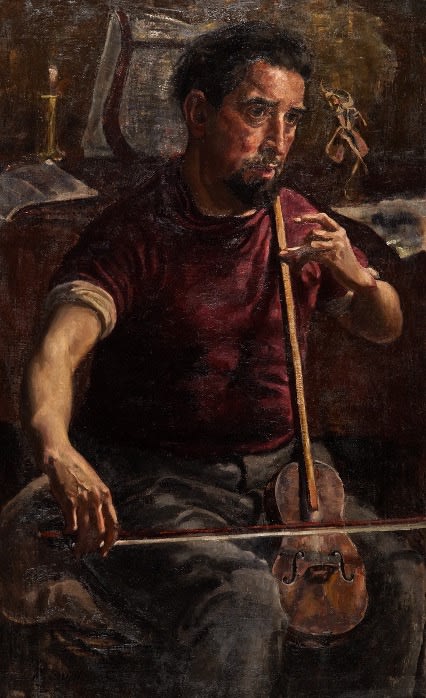Elected ARSA: 18 March 1936
Elected RSA: 10 February 1943
By the death of Robert Sivell RSA, the Royal Scottish Academy lost an earnest artist and a colourful personality.
Born in Paisley, 16th October 1888, and schooled there, he served an apprenticeship as an engineer, but early discovered a passion for Art. This led to taking evening classes under Mr. W. Laughland Cockburn, an imaginative teacher, who encouraged him to go to the Glasgow School of Art.
He studied there from 1908 to 1910, and from this period dates the friendship between him, Archibald McGlashan and the late James Cowie, a friendship which grew with the years and lasted to the end.
Then began a period of move and change. First of all, a return to engineering, then a two-year stay in Canada and America, and at the outbreak of the First World War, a spell in the Merchant Navy. 1916 saw Robert Sivell back in Glasgow, and a studio in West Regent Street. Now began his serious work of painting and attempts to exhibit. These were stringent days of hardship and austerity, which left a lasting mark on his outlook.
Because of repeated rejection of their works by the established Art bodies, the short-lived Society of Painters and Sculptors was formed in 1919. Sivell became one of the Presidents of this rebel group.
In 1923, Robert Sivell married Isobel Sayers of a Kirkcudbright family of boat-builders, and he settled there in the peace and seclusion of the still-lingering Art colony. From this union was born a daughter, Elspeth, whom he has used as a model for many of his most charming canvases.
A Botticellian flavour began to appear in Sivell's painting early in his career, and this led him to a new appraisal of the Renaissance and the great epoch of Italian Art. This love of the Renaissance grew into a passion and stayed with him undimmed all his life. So much so, that he judged every work by that standard and would not be shaken by any arguments. In 1921, it was possible for him to visit Italy and to see in reality what, up till then, he had seen only through reproductions.
He returned refreshed, invigorated and convinced that his own painting was in the true spirit of this great tradition. In this respect, Robert Sivell was a true Academician, and, when he was elected an Associate in 1937, became a staunch defender of the Academy. He was elected to full membership in 1943.
In 1936 he accepted an invitation to become Head of the Painting School of Gray's School of Art, Aberdeen, a post from which he retired to return to Kirkcudbright in 1954. This proved a fruitful period of active work. He took a delight in teaching the young and in leading them along his paths of truth and tradition.
Already two of his pupils are Associates of the Academy. It was in Aberdeen that Robert Sivell conceived and carried out the murals in the University Students' Union, a task of many years and many studies, and in which he has tried to embody and express his philosophy of Life and Art.
Robert Sivell's work is distinguished by his keen draughtsmanship and solidity of form. His colour, deep and mellow, is always used with a keen sense of refinement. Strong in conviction, he was an outspoken antagonist of the modern and his irony could be devastating. Yet his conversation was scintillating with humour, and his friendship, once won, was never in doubt.
Sivell is represented in the Municipal Galleries of Glasgow, Aberdeen, Belfast, Greenock and Paisley; also in the Diploma Collection of the R.S.A., and in numerous private collections.
During the Second World War, he was commissioned by the War Artists' Advisory Committee to carry out work for the Imperial War Museum.
He died on 17th April 1958 after a short illness, and his survived by his wife and his married daughter. The late John Lamont, A.R.S.A., was his brother-in-law.
RSA Obituary, transcribed from the 1958 RSA Annual Report

